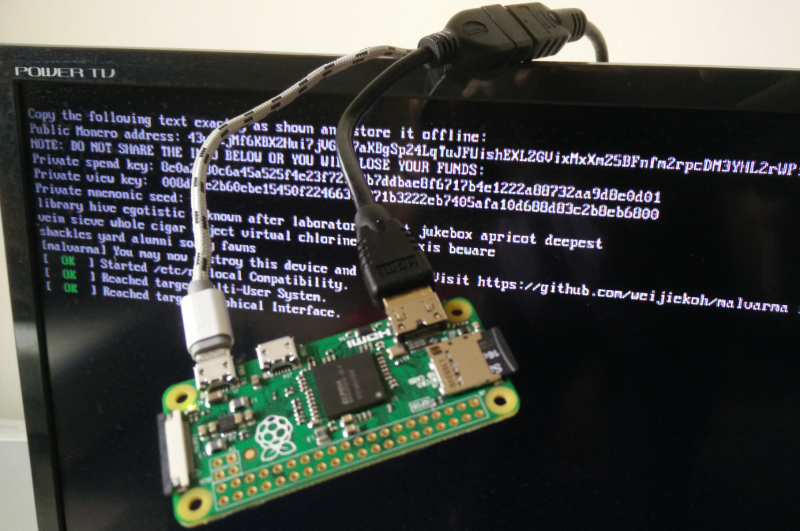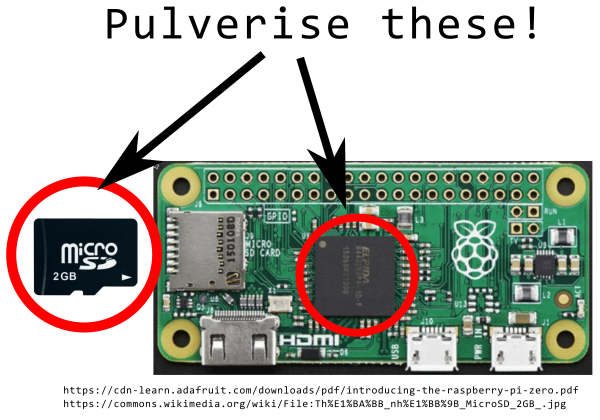https://github.com/weijiekoh/malvarma
Secure Monero cold wallets for the truly paranoid ❄❄❄
https://github.com/weijiekoh/malvarma
Last synced: 3 months ago
JSON representation
Secure Monero cold wallets for the truly paranoid ❄❄❄
- Host: GitHub
- URL: https://github.com/weijiekoh/malvarma
- Owner: weijiekoh
- License: mit
- Created: 2018-01-04T10:52:32.000Z (over 7 years ago)
- Default Branch: master
- Last Pushed: 2018-01-21T04:21:14.000Z (over 7 years ago)
- Last Synced: 2025-03-26T13:54:01.050Z (4 months ago)
- Language: Python
- Homepage:
- Size: 4.69 MB
- Stars: 17
- Watchers: 3
- Forks: 4
- Open Issues: 1
-
Metadata Files:
- Readme: README.md
- License: LICENSE
Awesome Lists containing this project
README
# Malvarma: Secure Monero cold wallets for the truly paranoid
Malvarma is a Raspberry Pi Zero image which lets you generate a Monero cold
wallet securely and easily.
**Malvarma is currently in an alpha release stage and has not been vetted for
security. Use at your own risk.**
**Do not run Malvarma on a Raspberry Pi Zero W** because it has wireless
connectivity and is therefore not an airgapped device.
**Do not run Malvarma on an Internet-enabled TV or any display device connected
to a network** for the same reason.
Here is Malvarma running on a Raspberry Pi Zero connected to a HDMI television
set (click for a [video](https://vimeo.com/251990871)):

It has been tested on a non-wireless Pi Zero v1.3 and Pi 3 Model B v1.2, but
should ideally only be run on the non-wireless Pi Zero as it is airgapped by
default.
## Running Malvarma
This guide is for Linux users, but savvy Windows or macOS users should be able
to perform equivalent steps on their machines.
### 1. Download the Malvarma image
Use any of these links to download the Malvarma image (300+ MB):
- [Dropbox](https://www.dropbox.com/sh/imxygsxfdek7mz9/AAB53XHmV6LYwAdKP4GNY6ALa?dl=0)
- [Mega](https://mega.nz/#F!SldQGZgY!9D6aqWp1niaemkS8tU2DqQ)
### 2. Unpack and verify the image
```bash
tar xf malvarma-0.1.1-alpha.tar.bz2 && \
cd malvarma-0.1.1-alpha && \
gpg --keyserver pgp.mit.edu --recv-keys 0x90DB43617CCC1632 && \
gpg --verify malvarma-0.1.1-alpha.img.sig malvarma-0.1.1-alpha.img && \
sha256sum -c malvarma-0.1.1-alpha.img.sha256
```
**Do not continue** if the SHA256 or GPG verification fails.
The following command burn the image to a microSD card assumes that the microSD
device is at `/dev/mmcblk0`:
```bash
sudo dd bs=4M if=malvarma-0.1.1-alpha.img of=/dev/mmcblk0 conv=fsync
```
Alternatively, use [Etcher](https://etcher.io/) to burn the image.
### 3. Boot the Raspberry Pi Zero
Insert the card into a non-wireless
[Raspberry Pi Zero](https://www.raspberrypi.org/products/raspberry-pi-zero/),
plug it into a HDMI screen, and then plug it into a USB power source. You
should plug in the HDMI cable *before* the micro USB cable because doing the
reverse could prevent the Raspberry Pi from correctly detecting your screen
resolution and thereby hide characters at the edges of the screen.
Note: this is a screenshot from QEMU, and does not precisely reflect the
output of an actual Raspberry Pi running Malvarma.

After a few minutes, a mnemonic seed, private spend/view keys, and public
address should automatically show up on the screen. Write down multiple copies
of this information and store them safely.
**Do not take a picture of the screen with a camera or store the private keys
on any electronic device.**

### 4. Optional: destroy the Raspberry Pi Zero and microSD card
Following this visual guide, destroy particular components of the Raspberry Pi
Zero using sharp hand tools. Specifically, destroy the microSD card and the
Raspberry Pi's BCM2835 processor. According to
[Adafruit](https://cdn-learn.adafruit.com/downloads/pdf/introducing-the-raspberry-pi-zero.pdf),
the Pi Zero's RAM sits on top of its processor, so be sure to destroy both.
Wear eye protection and use a hammer and screwdriver or nail to break through
their plastic coatings and pulverise their silicon innards.
For inspiration, refer to this article from The Guardian:
[Footage released of Guardian editors destroying Snowden hard drives
](https://www.theguardian.com/uk-news/2014/jan/31/footage-released-guardian-editors-snowden-hard-drives-gchq)

While this is a little extreme, the device is inexpensive and small, and some
users may wish to maximise their peace of mind. If you don't want to destroy
the device, at least store it in a safe place and do not use it until you you
empty your cold wallet of all funds and no longer use that address.
## Want to buy me a coffee?
Please send XMR to
`4B4CBHf9qu8e67JWRYASFKTLT42fQCLHsDNDxzW71CjqRNtw8ZBN5rU1pPiVZEDPgv9rHfs23VpE9jpSrLpkWqmEQsbfj6i`
to support the author - thank you!
## What is a cold wallet?
If you wish to store moneroj [1] for a long period of time without spending
them, it is a good idea to put them in a cold wallet, also known as [cold
storage](https://www.investopedia.com/terms/c/cold-storage.asp). Cold wallets
are created and stored in a such a way that the only way to spend the funds in
them is to have physical access. As such, they should only be kept offline,
and should be generated by devices which have never and will never be connected
to the Internet.
## Why not use some other tool?
There is nothing intrinsically wrong with existing solutions, such as
[moneromooo's offline wallet
generator](https://github.com/moneromooo-monero/monero-wallet-generator). It is
absolutely possible to use such tools securely. Malvarma only seeks to go
one step further to provide a solution which accounts for *both* hardware and
software security, while making the entire process as foolproof as possible.
## Why use Malvarma?
Unfortunately, it is not easy to create a cold wallet securely. Several
problems stand in the way, so Malvarma seeks to mitigate them.
### Network interfaces
**Problem:** A cold wallet should be generated using processes and
devices which have as few attack surfaces as possible. Network connectivity is one
such attack surface though which an attacker may (hypothetically) leverage to
extract private keys.
**Solution:**
A cold wallet should be generated in an
[air-gapped](https://en.wikipedia.org/wiki/Air_gap_(networking)) device. While
it is possible to disable wireless adapters on most PCs or laptops, the
non-wireless version of the Raspberry Pi Zero is *always* air-gapped, so it
avoids this entire class of vulnerabilities.
Note that this only matters if you don't want to have to *trust* that your device
can indeed turn its wireless adapter off. Again, this is a guide for the highly
security-conscious, and assumes an extremely low risk appitite.
### Malware
**Problem:** A device may be infected with malware without the user knowing.
Even if a cold wallet is generated offline, sufficiently sophisticated malware
may transmit it to an adversary if the device gets online.
**Solution:** A legitimate copy of Malvarma will not contain malware, and it
will be possible to ensure that this is so. Each Malvarma image will be
cryptographically signed and users should verify it before use. More advanced
users will be able to inspect, reproduce, and verify that the published
Malvarma image is exactly as advertised.
### Data destruction
**Problem:** Traces of private keys may remain on one's device even if they are
deleted or after it is shut down. [2] [3] The only way to be absolutely sure is
device to generate your keys and physically destroy the device after use.
Although this is prudent, it is wasteful to destroy electronics, and disposing
electronic waste can harm the environment.
**Solution:** A Raspberry Pi Zero only costs USD$5 and is very small. It is
therefore more economical and relatively less harmful to the environment to
destroy after use.
### Ease of use
**Problem:** It is not trivial to set up a secure computing environment.
Rather than go through the hassle of setting up a USB-bootable Linux
distribution on an airgapped device just to create a cold wallet, a
less-determined user may opt to do so on the system they regularly use, and
thereby defeat the purpose of the entire exercise.
**Solution:** Each Raspberry Pi Zero is the same as the next. By encapsulating
a wallet generator into a microSD image, Malvarma eliminates the problem of
installing software on an airgapped device. The goal is to make it plug-and-play.
## What about hardware wallets?
Some users find hardware wallets an acceptable alternative to cold wallets as
they strike a balance between usability and security. [4] Yet at the time of
writing (early January 2018), there are no commercially available hardware
wallets for Monero, although Ledger support is reportedly [in the
works](https://www.reddit.com/r/Monero/comments/7de2pj/ledger_hardware_wallet_monero_integration_some/).
Note: **Malvarma is neither a hardware wallet, nor will it store any generated
wallets. You must write down the private keys and mnemonic seed before sending
any funds to your cold wallet.**
## Development roadmap
Completed:
- 11 January 2018: `0.1.1-alpha` relased for testing
Future plans:
- End-January 2018
- Release a version which provides 2-of-3 split keys using
[Shamir's Secret Sharing](https://en.wikipedia.org/wiki/Shamir%27s_Secret_Sharing)
- Release Malvarma for other cryptocurrencies.
## Building Malvarma
If you want to make a copy of Malvarma yourself, follow these instructions.
They have been tested on Ubuntu 17.10.
### 1. Install dependencies:
```bash
sudo add-apt-repository "deb http://archive.ubuntu.com/ubuntu $(lsb_release -sc) universe" && \
sudo apt update && \
sudo apt -y install libguestfs-tools git python3 coreutils wget axel
```
### 2. Download and verify required files:
```bash
git clone https://github.com/weijiekoh/malvarma.git && \
cd malvarma && \
git clone https://github.com/weijiekoh/py2-monero-wallet-generator.git && \
sh download_raspbian.sh
```
If the `download_raspbian.sh` command fails, **do not continue** as the
Raspbian image may have been tampered with, and should be considered
unsafe.
### 3. Build a Malvarma image
```bash
sudo python3 build.py
```
Note: `build.py` requires root permissions through `sudo` because
`guestmount` [does not work](https://bugs.launchpad.net/fuel/+bug/1467579) for
non-root users.
#### What `build.py` does
`build.py` configures the Raspberry Pi image as follows:
- Disables WiFi and Bluetooth (in case it's run on a wireless-enabled Raspberry
Pi)
- Removes some unnecessary system services (to make Raspbian boot faster)
- Configures /etc/rc.local to perform these tasks upon boot:
- Install `rng-tools` and check for sufficiently high entropy using `rngtest`
- If `rngtest` passes with a maximum of 5 out of 1000 FIPS-140-2 failures, run
[py2-monero-wallet-generator](https://github.com/weijiekoh/py2-monero-wallet-generator)
to generate and display the keys to a cold wallet
Note that `build.py` is **not deterministic**. The output file
(`raspberry/malvarma-.img`) is likely to differ over multiple runs,
even if it uses the same original Raspbian image and Malvarma code. This is
probably because `libguestfs` is also non-deterministic. If anyone has
suggestions on how to deterministically modify raw disk images, please contact
the author. In the meantime, please audit the code yourself if you want to
fully trust it.
Malvarma uses the `rng-tools` package:
`raspberry/rng-tools_2-unofficial-mt.14-1_armhf.deb`. To verify the
authenticity of this file, refer to
[verify_rng-tools.md](https://github.com/weijiekoh/malvarma/blob/master/verify_rng-tools.md).
### 4. Output `.img` file
The built `.img` file will be in the `build/` directory, and is ready to be
burned to a microSD card.
You may choose to emulate the image using QEMU, but since QEMU will modify the
image, **remember to delete and rebuild it when you are done**.
```
sudo apt -y install qemu-system-arm
python3 qemulate_malvarma.py build/malvarma-.img
rm -rf build/malvarma-.img
```
## What does *malvarma* mean?
Malvarma is Espernanto for cold.
## Notes
[1] In Espernanto, *moneroj* is the plural of *monero*, or coin.
[2] A [cold boot attack](https://en.wikipedia.org/wiki/Cold_boot_attack), for
instance, may retrieve data computer memory even if it has been rebooted,
albeit within a timeframe of seconds to minutes.
[3] Some operating systems use on-disk swap files as temporary working memory
storage. Sensitive data, including private keys, [may find their way into swap
files](http://www.iusmentis.com/technology/encryption/crashcourse/security/),
and a determined adversary may be able to extract them.
[4] The [Ledger](https://www.ledgerwallet.com/products/ledger-nano-s), for instance,
uses a secure element to store private keys, which makes it easy to spend coins
without exposing any private keys.